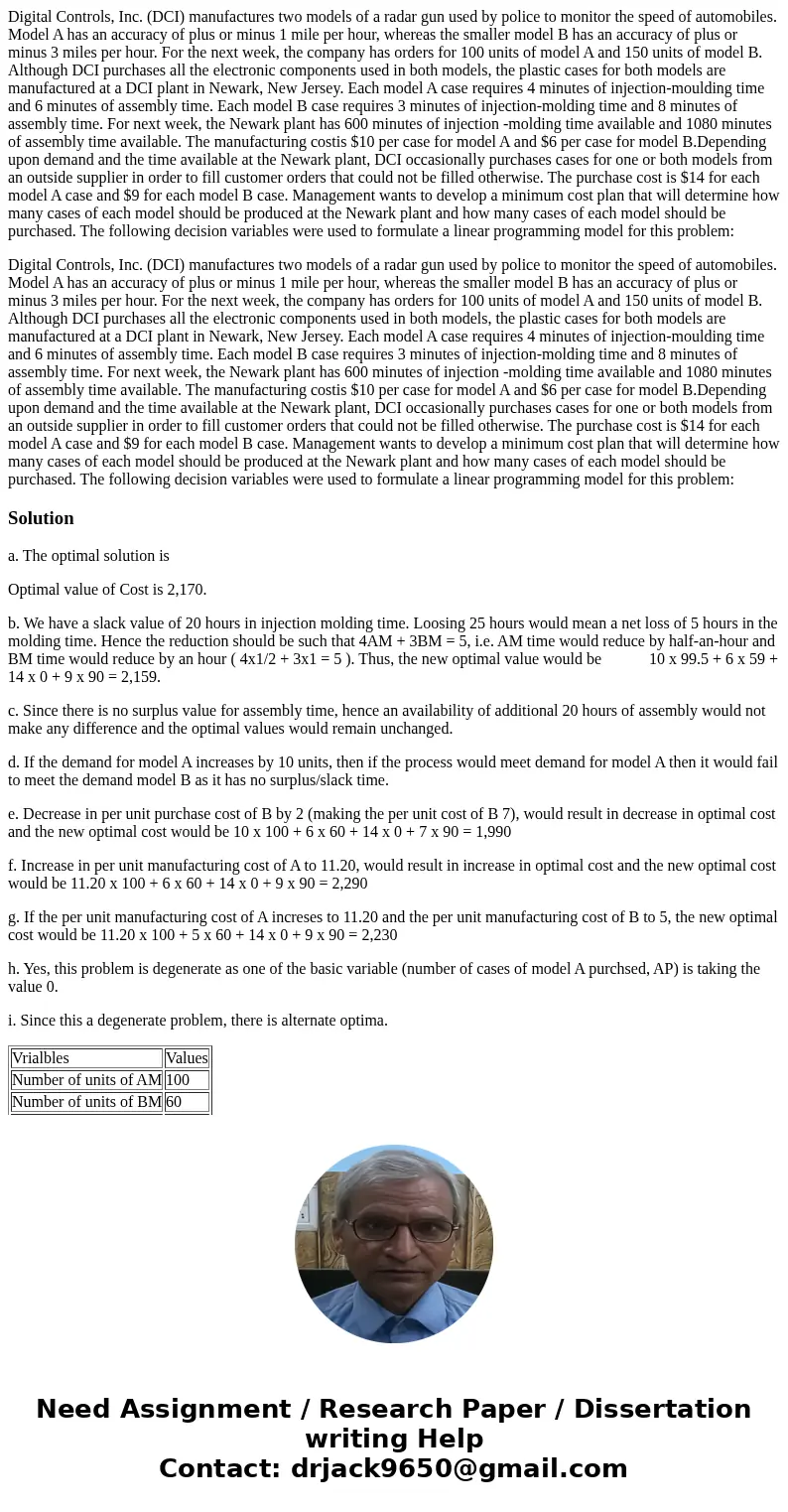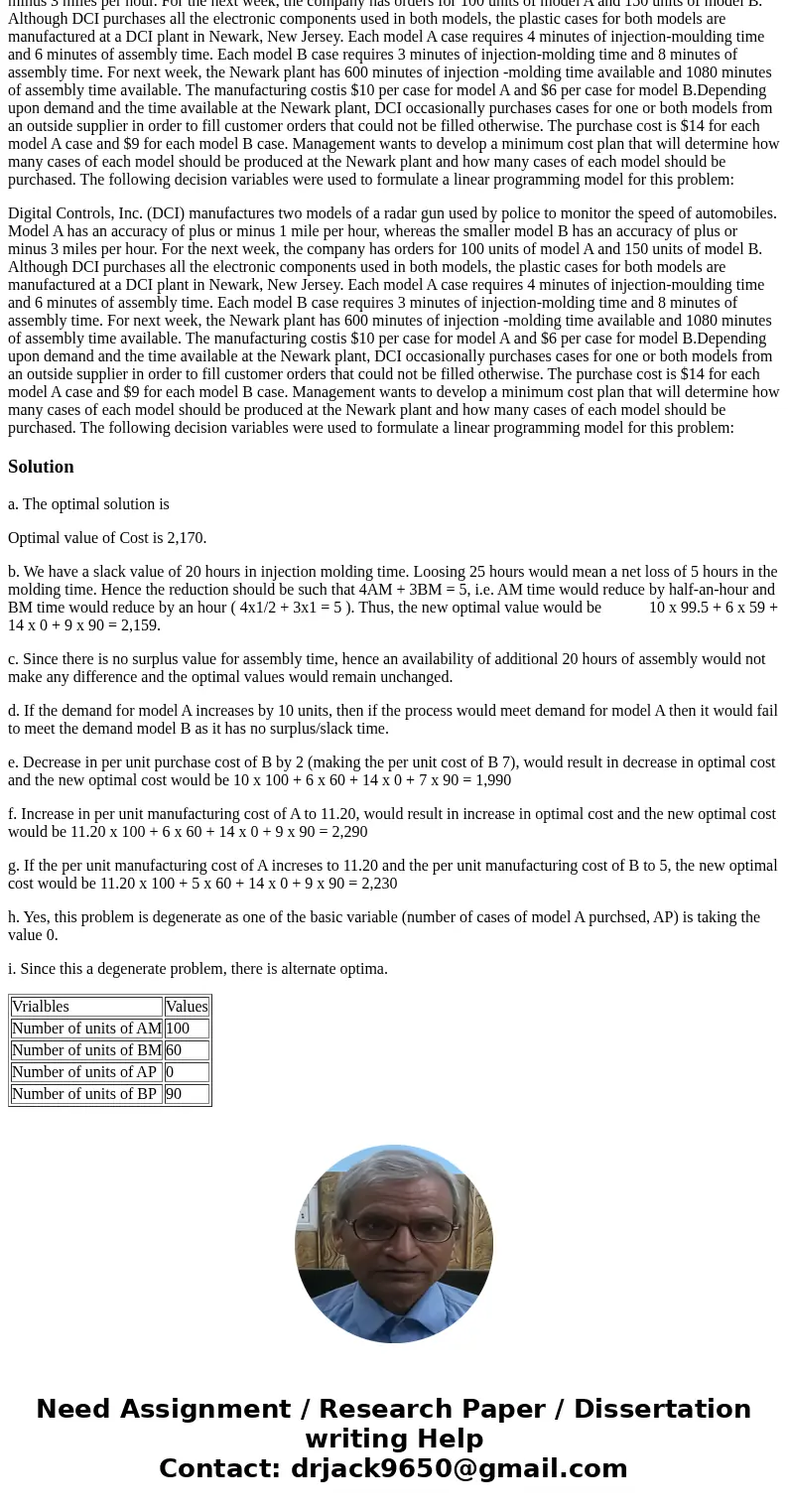Digital Controls Inc DCI manufactures two models of a radar
Digital Controls, Inc. (DCI) manufactures two models of a radar gun used by police to monitor the speed of automobiles. Model A has an accuracy of plus or minus 1 mile per hour, whereas the smaller model B has an accuracy of plus or minus 3 miles per hour. For the next week, the company has orders for 100 units of model A and 150 units of model B. Although DCI purchases all the electronic components used in both models, the plastic cases for both models are manufactured at a DCI plant in Newark, New Jersey. Each model A case requires 4 minutes of injection-moulding time and 6 minutes of assembly time. Each model B case requires 3 minutes of injection-molding time and 8 minutes of assembly time. For next week, the Newark plant has 600 minutes of injection -molding time available and 1080 minutes of assembly time available. The manufacturing costis $10 per case for model A and $6 per case for model B.Depending upon demand and the time available at the Newark plant, DCI occasionally purchases cases for one or both models from an outside supplier in order to fill customer orders that could not be filled otherwise. The purchase cost is $14 for each model A case and $9 for each model B case. Management wants to develop a minimum cost plan that will determine how many cases of each model should be produced at the Newark plant and how many cases of each model should be purchased. The following decision variables were used to formulate a linear programming model for this problem:
Digital Controls, Inc. (DCI) manufactures two models of a radar gun used by police to monitor the speed of automobiles. Model A has an accuracy of plus or minus 1 mile per hour, whereas the smaller model B has an accuracy of plus or minus 3 miles per hour. For the next week, the company has orders for 100 units of model A and 150 units of model B. Although DCI purchases all the electronic components used in both models, the plastic cases for both models are manufactured at a DCI plant in Newark, New Jersey. Each model A case requires 4 minutes of injection-moulding time and 6 minutes of assembly time. Each model B case requires 3 minutes of injection-molding time and 8 minutes of assembly time. For next week, the Newark plant has 600 minutes of injection -molding time available and 1080 minutes of assembly time available. The manufacturing costis $10 per case for model A and $6 per case for model B.Depending upon demand and the time available at the Newark plant, DCI occasionally purchases cases for one or both models from an outside supplier in order to fill customer orders that could not be filled otherwise. The purchase cost is $14 for each model A case and $9 for each model B case. Management wants to develop a minimum cost plan that will determine how many cases of each model should be produced at the Newark plant and how many cases of each model should be purchased. The following decision variables were used to formulate a linear programming model for this problem:Solution
a. The optimal solution is
Optimal value of Cost is 2,170.
b. We have a slack value of 20 hours in injection molding time. Loosing 25 hours would mean a net loss of 5 hours in the molding time. Hence the reduction should be such that 4AM + 3BM = 5, i.e. AM time would reduce by half-an-hour and BM time would reduce by an hour ( 4x1/2 + 3x1 = 5 ). Thus, the new optimal value would be 10 x 99.5 + 6 x 59 + 14 x 0 + 9 x 90 = 2,159.
c. Since there is no surplus value for assembly time, hence an availability of additional 20 hours of assembly would not make any difference and the optimal values would remain unchanged.
d. If the demand for model A increases by 10 units, then if the process would meet demand for model A then it would fail to meet the demand model B as it has no surplus/slack time.
e. Decrease in per unit purchase cost of B by 2 (making the per unit cost of B 7), would result in decrease in optimal cost and the new optimal cost would be 10 x 100 + 6 x 60 + 14 x 0 + 7 x 90 = 1,990
f. Increase in per unit manufacturing cost of A to 11.20, would result in increase in optimal cost and the new optimal cost would be 11.20 x 100 + 6 x 60 + 14 x 0 + 9 x 90 = 2,290
g. If the per unit manufacturing cost of A increses to 11.20 and the per unit manufacturing cost of B to 5, the new optimal cost would be 11.20 x 100 + 5 x 60 + 14 x 0 + 9 x 90 = 2,230
h. Yes, this problem is degenerate as one of the basic variable (number of cases of model A purchsed, AP) is taking the value 0.
i. Since this a degenerate problem, there is alternate optima.
| Vrialbles | Values |
| Number of units of AM | 100 |
| Number of units of BM | 60 |
| Number of units of AP | 0 |
| Number of units of BP | 90 |


 Homework Sourse
Homework Sourse